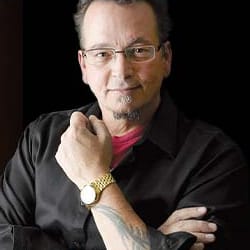Wild Beat Communication - The Lagrange Point Vol. I, Iss. 9
Holy blap! I finally remembered to update the Excerpt text! MADE YOU LOOK

Welcome to the ninth issue of The Lagrange Point! If you aren't familiar with this budding e-newsletter, you can find out more in this post here.
In This Issue
Distant Early Warnings
- Two awesome novellas with radically different vibes, and more!
Crafter's Corner
- Baby's first Gunpla
Rantables
- The insidious myth of overpopulation
And Lastly, A Word
- Celebrate Labour day with worker-centric flicks
Distant Early Warnings
Upcoming releases and events of Canadian geek things
We've got comics, we've got conventions, and we've got cool things besides! Here's what's coming up in Canada's geek scene.

I saw a preview of this comic/novella, entitled Aardehn: Awakening, at Fan Expo, and I found the neon-drenched colour scheme to be gorgeous. The novella is being published by Toronto-based indie publisher RAID PRESS, and the Kickstarter to fund the run of the book closes on September 10. From the preview sample I saw at Fan Expo, it's an interesting project that blends prose and illustration for a product that leans towards the "novel" part of graphic novel.

As the convention season rolls on, London Comic Con, running Sept 14 to 15, deserves a special highlight. The Con has gone all in on Teenage Mutant Ninja Turtles, and their guest of honour is Kevin Eastman, co-creator of the iconic comic book. They also have actors like James Saito (Shredder) and Paige Turco (April O'Neil) from Secret of the Ooze, and other TMNT-related folks. For those in the Toronto/Hamilton area, maybe a day trip out to London could be fun!

Turning back to London, Ontario, we find a small board game team Kickstarting Godori Hwatu, a new take on a traditional Korean card game. My Dear Games is a company run by a Korean family making the game, which features beautiful, flower-focussed artwork. They say their game is a take on Korea's "go-stop" card game, and they're hoping to bring the game to western audiences with their own unique take!

To wrap this week up, SF&F literature in Canada continues to deliver, with a new release from ECW Press: Countess, by Suzan Palumbo. The Trinidadian-Canadian author has been nominated for the Nebula, World Fantasy, and Aurora Awards, and resides in Brampton. Her new novella sees a betrayed captain who seeks revenge on the interplanetary empire that subjugated her people for generations. Sounds badass!
Crafter's Corner
Baby's First Gunpla
My quick visit to Toronto's Fan Expo led me to a pretty nifty workshop: a how-to on the ins and outs of Gunpla, hosted by SIDE6 Mecha Modelling Club and Gunpla Montreal. I signed up to build a kit from the series I grew up on, Gundam Wing.

If you're not familiar with the term, "Gunpla" is a portmanteau of "Gundam Plastic (Models)," and refers broadly to a sub-category of plastic model kits that feature the mecha robots and battle suits of the Gundam series, a long-running Japanese manga and anime intellectual property.
The kits are typically snap-together and require no glue, and the figures that they assemble into are usually movable, with optional weapons or other accessories. Other anime series, like Neon Genesis: Evangelion, have also released kits, but they are still referred to as "Gunpla" kits by virtue of having the same kind of mechanics as the Gundam ones.

The other big thing that sets Gunpla apart from other plastic model kits is that the sprues (or runners, as they're known in the community) are often multi-coloured, meaning that you don't necessarily even need to paint the model once it's assembled.
There are a few different "grades" of Gunpla, representing kits of different quality:
- SD (Super Deformed) - these kits usually have exaggerated cartoon features, hence the "super deformed" name. They're beginner friendly, and good for kids
- HG (High Grade) - the "standard" grade rating for most kits of 1/144 scale. Not super complicated but of reasonable quality.
- RG (Real Grade) - a step up from HG that has more detail and parts
- MG (Master Grade) - a larger scale at 1/100, with more points of articulation and more details
- PG (Perfect Grade) - big kits at 1/60 scale, and their posability can even include finger articulation
But back to my kit from Gundam Wing. For reference, the workshop was about two hours. Here's how far I got at Fan Expo:

I finished up the remaining steps at home in about three more hours. It's interesting how the assembly of a Gunpla is rather different from the other model kits I've worked with over the years.
For starters, because there's no gluing of parts, there's a lot more focus on getting the parts cut off properly from the runner. The recommended method is to cut a short distance away from the part itself, then to nip off the nubs that you left behind, once a part is totally free. This helps reduce the risk of distorting the part, which can lead to discolouration.
Also, with the points of articulation, in my hands, the model feels much more like and action figure. They also make use of stickers instead of decals, which help enhance the model's appearance without any painting.
And the end result is honestly pretty good!



It's really interesting to see how these things occupy this weird intersection between action figure and plastic model. In particular, this Gundam transforms, with a few little steps, into a "flight mode." Just like in the series!
I have a few more Gunpla kits in my backlog, and with the workshop tips, I definitely feel more prepared to tackle them! Thanks to SIDE6 and Gunpla Montreal for the informative and fun workshop.
Rantables
Make room! Make room! (for more resources and equity)

Forty-five years ago, on June 1, Chen Yun, a senior member of the Chinese Communist Party and a major architect of the revolution alongside Mao Zedong, commented to Chen Muhua, the head of the Party's population control group:
"The immediate, primary task is to advocate each couple have just one child. The resultant problems are secondary."
(Chen Yun and the Chinese Political System, David M. Bachman)
Nearly 30 years after Chen Yun's death, the resultant problems are now primary. With a rapidly aging population and a male-to-female ratio of 104.5 to 100, the country could be facing a severe labour shortage and a horrendously low birth rate of just 1.09 children per couple.
China has now flipped the script and is urging women to have more children, but the women, who, it must be noted, suffered under a patriarchal society that used sex-selective abortion and even infanticide to prioritize sons under the one-child policy, are telling the government to get stuffed — which demonstrates that the common factor in obsession with overpopulation is, in fact, existing prejudice.

Which is what I'd really like to talk about here.
Overpopulation, it must first be emphasized, is an unproven theory. It dates back to the 19th century and was chiefly popularized by Thomas Robert Malthus, for whom the theory is often referred as "Malthusianism." Under Malthus' ideas, population growth is exponential and is tied to increased agricultural yields, but this eventually leads to the outpacing of access to resources, which jacks up prices, and then causes social unrest, leading to war or famine, and a correction in population (read: mass death).
A lot of critics have come out against Thomas Malthus over the years, all the way back to his first proposed ideas. My personal favourite criticism comes from Karl Marx, who wrote that Malthusianism was "nothing more than a school-boyish, superficial plagiary of Defoe, Sir James Steuart, Townsend, Franklin, Wallace."
In fact, it wasn't just ol' commie Marx who detested Malthusianism. The modern-day Fraser Insititute has also strenuously denied the theory of overpopulation, as has the left-wing environmental Sierra Club, after an earlier period in the 1970's, where they were buying into the panic.
Indeed, the 1970's are one of the many times this theory has reared its ugly head, and it seems to be doing so again, in the midst of the climate crisis. Once more, we see some columnists and half-assed thinkpieces placing the blame for our environmental collapse at the feet of too many darn kids.
What's common between this latest panic and the earlier ones is that they all come with a knowing wink that CERTAIN PEOPLE are less desirable than others. In China, that took the form of societal misogyny, preferring boys to girls. In the climate change vernacular, over and over again we see North Americans tossing blame at the feet of "India and China," those two evil pollutors.
But the fact is that on a per capita basis, the world's worst contributors to climate change are wealthy and less-populated nations like Canada and the United States, where the carbon footprint of the average citizen far exceeds that of a person in the Global South, and where billionaires proliferate at a similarly high per capita basis.
Indeed, if we look at Taylor Swift, society's "good billionaire," her 2022 private jet emissions (and ONLY those emissions; no car trips or meat or other consumption included) made her carbon footprint 1,800 times larger than the average person's annual emissions.
In other words, for one Taylor Swift we could have 1,800 more people on the face of the planet, and not notice any difference. And so it goes with the disproportionate consumption of a North American to a European, and then a European to an African, etc.
The common thread in all of this is that when we talk about overpopulation, what we're really doing is ducking responsibility for the actions of a global elite compared to the have-nots, and the insidious underlying tons therein typically end up falling along lines of gender, race or other characteristics. There's a reason eugenics, for instance, is close bedfellows with Malthusianism.
In fact, what we have seen in recent trends of birth rates is that women, once empowered with equal rights and opportunities, will naturally favour not going through the DELIGHT of childbirth as many times as possible. Put more simply, when people's basic needs are provided for, and they are less-influenced by systems of control like government family planning and religious institutions, and they have access to the advantages of advanced medical care, including birth control, they tend to not feel the need to have numerous offspring.
We do not fix the world by shrinking the number of people who have access to these things. We fix it by redistributing what resources we have more equitably, and fairly.
And Lastly, a Word
Celebrate Labour Day with some worker-centric flicks
- Danny, Brassed Off
If you read that quote and found yourself humming "We'll be singing...when we're winning..." that's not an accident. Chumbawumba, the band behind "Tubthumping," was an unabashedly anarcho-communist group, and I mean that in the most traditional sense. They were staunchly pro-worker, pro equal rights, and anti-fascist, and even their dumbest song (and their biggest hit) contains a deliberate reference to a working-class movie with that opening sound clip.
And that's what I'm going to talk about, in brief, today: movies of the worker class. It may not surprise you to learn that they are shockingly sparse, in comparison to the absolute MOUNTAINS of war movies that America puts out. Go figure.
Here are five movies to celebrate Labour Day with.

- Brassed Off (1996)
Overshadowed by the also-good The Full Monty in 1997, Brassed Off is a musical comedy with an ensemble cast that includes Ewan MacGregor and Pete Postlethwaite, set in the 80's in small-town UK. A local brass band made up of miners on the verge of joblessness due to the Thatcher government's union busting and program of coal pit closures desperately competes for a National competition, in a show of solidarity and camaraderie against the man. It has some terrific quotes in it, including Danny's quote above, but especially one of the miner's blunt assessment of the Tory party, which comes in a bleak moment at a children's birthday party. - Fast Food High (2003)
OKAY LOOK. This movie is not particularly good — it may even be pretty bad. But god help me, I have a soft nostalgia part for it, because it introduced me to Allison Pill, who I always have time for, and because it takes place in Ontario. Shot mainly at Port Credit Secondary School in Mississauga, the film sees Pill as a fast food worker who attempts to form a union, which leads to friction with her classmates and coworkers. It's a bit heavy on the literal High School Drama, but I think the union struggle is sincere. - Deep Space Nine: Bar Association (1996)
Okay, I'm cheating by including a TV show, but dammit, this is one of the most celebrated, meme-worthy, pro-union episodes of one of the world's biggest franchises. Star Trek dives into labour politics emphatically on the side of the worker, with Chief Engineer Miles O'Brien inspiring perpetually beaten-down Rom with the story of his father — not just a hero, a UNION MAN — to fight back against crooked enterpeneur Quark (Rom's own brother!). When Rom is literally throwing Marx quotes in his brother's face, you know shit's gonna be good. - Il Postino (1994)
This one focuses less on worker rights than it does on romance, but I include it for two reasons. Firstly, it celebrates the life of Pablo Neruda, and doesn't omit the fact that the Chilean poet was a staunch communist. And secondly, its working-class hero, the titular postman, Mario, is also a communist, and...well, let's just say that his status becomes pivotal in the film's final moments. I think this film is a handy reminder to certain ignorant doofuses that the "first they came for" poem literally starts with "the socialists." - Norma Rae (1979)
In probably the most iconic movie on this list, Sally Field stars as the title character in a role that won her an Oscar for Best Actress. Norma Rae works at a cotton mill, and is inspired by big city union organizer Reuben Warshowsky to unionize her shop. The film was written by Jewish-American filmmaker Martin Ritt, a victim of the Hollywood Blacklist. Norma Rae, as Sally Field said in her acceptance speech, IS Martin Ritt, and she kicks ass. I dare you not to shed a tear of worker solidarity during her Union sign scene.

That wraps up the ninth issue of The Lagrange Point! If you enjoyed this little e-newsletter, please consider subscribing, or, if you're already subscribed, sharing it with a friend or family member!
I can't grow this e-newsletter alone. I need lots of mouths spreading lots of words about why people should read The Lagrange Point.
Until next Monday, thank you for reading!
-Tim



